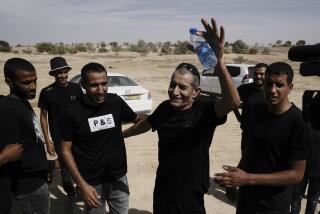Outpost Dispute Heats Up in Israel
GIVAT HATAMAR, West Bank — Atop a stony ridge, neat rows of concrete nubs sprout from a tract of freshly scraped earth.
The concrete stumps, which serve as foundations for mobile homes, can accommodate about a dozen houses -- enough to double the size of this tiny Jewish community about 12 miles south of Jerusalem. Local Jewish leaders say that is exactly the plan, with the hilltop absorbing newcomers from the neighboring settlement of Efrat.
But signs of new construction dismay Israeli activists and Palestinians who contend that such clusters -- offshoots of Jewish settlements, commonly called outposts -- are meant to be dismantled by Israel, rather than expanded.
The West Bank outposts, some of them full-fledged neighborhoods with paved roads and electrical service and others barely more than a few crude trailers, have become a growing source of friction between Israel and the United States.
Under terms of the U.S.-backed diplomatic initiative known as the road map, Israel is to remove all outposts built since March 2001 and to freeze expansion of established settlements. Israel says it has dismantled a number of outposts, which critics call impediments to peace, but U.S. officials have expressed impatience with the pace of the effort.
That was evident last week in a meeting in Washington between Secretary of State Colin L. Powell and Israeli Foreign Minister Silvan Shalom.
Powell described the Bush administration’s frustration in unusually blunt language, telling reporters, “We have some disappointment in the rate at which outposts have been removed.”
Shalom said Israel had dismantled “tens” of outposts -- a figure he gave as 81 during a briefing later with Israeli reporters. But Palestinians and Israeli activists who track the growth of Jewish settlements in the West Bank reject the Israeli government assertions.
The Israeli group Peace Now says Israel has removed about 25 outposts in the last two years. That leaves about 100, nearly half of which should be dismantled under terms of the peace plan, the group says.
But according to a list that Israel recently provided to U.S. officials, only 28 outposts remain. It does not include Givat Hatamar, which is served by a paved road and hooked to the national power grid.
“Not only is it not on the list, it’s expanding,” said Dror Etkes, head of Peace Now’s settlement watch project.
Officials at the Israeli Defense Ministry, which prepared the government’s roster, declined to comment on individual outposts but said the list included those built without government permits since March 2001.
Shalom, the foreign minister, said in a radio interview after his meeting with Powell that some of the 28 listed outposts were in “various stages of dismantlement, and the rest are subject to judicial proceedings.”
He said Israel remained committed to removing the outposts, which supporters consider lawful communities.
A day before Shalom met with Powell, Israeli defense officials named five outposts that were to be torn down.
Often, the outposts are moved or erected later on the same spot and inhabited anew. One outpost near the city of Hebron has been dismantled by Israeli authorities at least seven times.
An Israeli government audit issued in May found that the Housing Ministry had improperly funneled nearly $6.5 million for construction of outposts during the previous three years.
Critics say Israel’s failure to take broad and lasting action has allowed some outposts to grow, even as new ones take root, complicating prospects for future evacuation.
Jewish settlers in the West Bank and Gaza Strip say the outposts are natural extensions of growing communities, and they cite the government’s past help -- through road-paving and other crucial assistance -- as evidence that the outposts are not rogue installations.
They “are not illegal outposts but rather neighborhoods of existing communities,” said Josh Hasten, spokesman for the Yesha Council, the main settlers group.
“Regardless of what promises Israel made to the Americans, or vice versa, these communities are continuing to grow, to thrive,” Hasten said. “You have synagogues, kindergartens and playgrounds being built.”
Etkes, the activist, would agree that the outposts show little sign of disappearing. Guiding a four-wheel-drive pickup through a ridge between two established settlements, he showed a pair of journalists the enclave of Netiv Haavot, which he said appeared in November 2001. At least half a dozen stone-sided houses are in place or under construction alongside the trailers.
“This is the real picture,” Etkes said. “Everything that is not being evacuated is growing.”
More to Read
Sign up for Essential California
The most important California stories and recommendations in your inbox every morning.
You may occasionally receive promotional content from the Los Angeles Times.










